Brief

Executive Summary
- Digital platforms are spreading throughout insurance markets, some featuring integrated services beyond the core product.
- Bain’s new global consumer survey finds that many respondents are open to buying insurance products on platforms from technology firms and other noninsurers, especially in health markets. Insurers maintain an edge for services in auto and home markets.
- One challenge for insurers is deciding whether they should build their own platform or participate in another firm’s. Another is to determine what success looks like with a platform.
- Leading platform participants have also developed a compelling hook that engages customers and achieves great delivery, scale and a viable path to profitability.
The rise of digital platforms that bring together multiple providers to market their wares is spreading through markets for health, auto and home insurance. Many customers clearly want to use platforms, as seen by the rise in traffic and expressed preferences in Bain & Company’s consumer surveys over the past couple of years.
Some platforms such as Policy Genius are marketplaces that essentially function as brokers. Others take a different form than marketplaces, being owned by insurers that attempt to engage customers with an ecosystem of integrated services beyond the core insurance product.
In principle, platforms give insurers a relatively low-cost, always-on channel for reaching a larger base of potential customers. When done right, those platforms with value-added services make the economics more attractive through stronger customer loyalty. That will be essential to minimizing commoditization and staying competitive.
Consider the analogy of automotive markets. For decades, auto manufacturers have improved quality and added features to sustain the price points for their products. Some of these features may command a separate fee—satellite radio, extended warranties—but over time most features become table stakes in the industry. If cars evolve to mobility as a service with a subscription revenue model, integrated services will become even more important.
Yet succeeding in the platform game is hardly straightforward. It requires smart strategic choices, plus a disciplined go-to-market approach that includes simple products, a great experience that engages customers, and strong marketing paths to monetization.
Vying for consumers’ favor
The opportunities have become more tangible now that platforms are addressing a range of customer needs, and interest is rising worldwide, a new Bain survey of 135,000 consumers in 17 countries finds. Respondents in China, India have the highest rate of insurance research and purchase on digital platforms (see Figure 1).
Digital insurance platforms have the highest use and interest in emerging markets

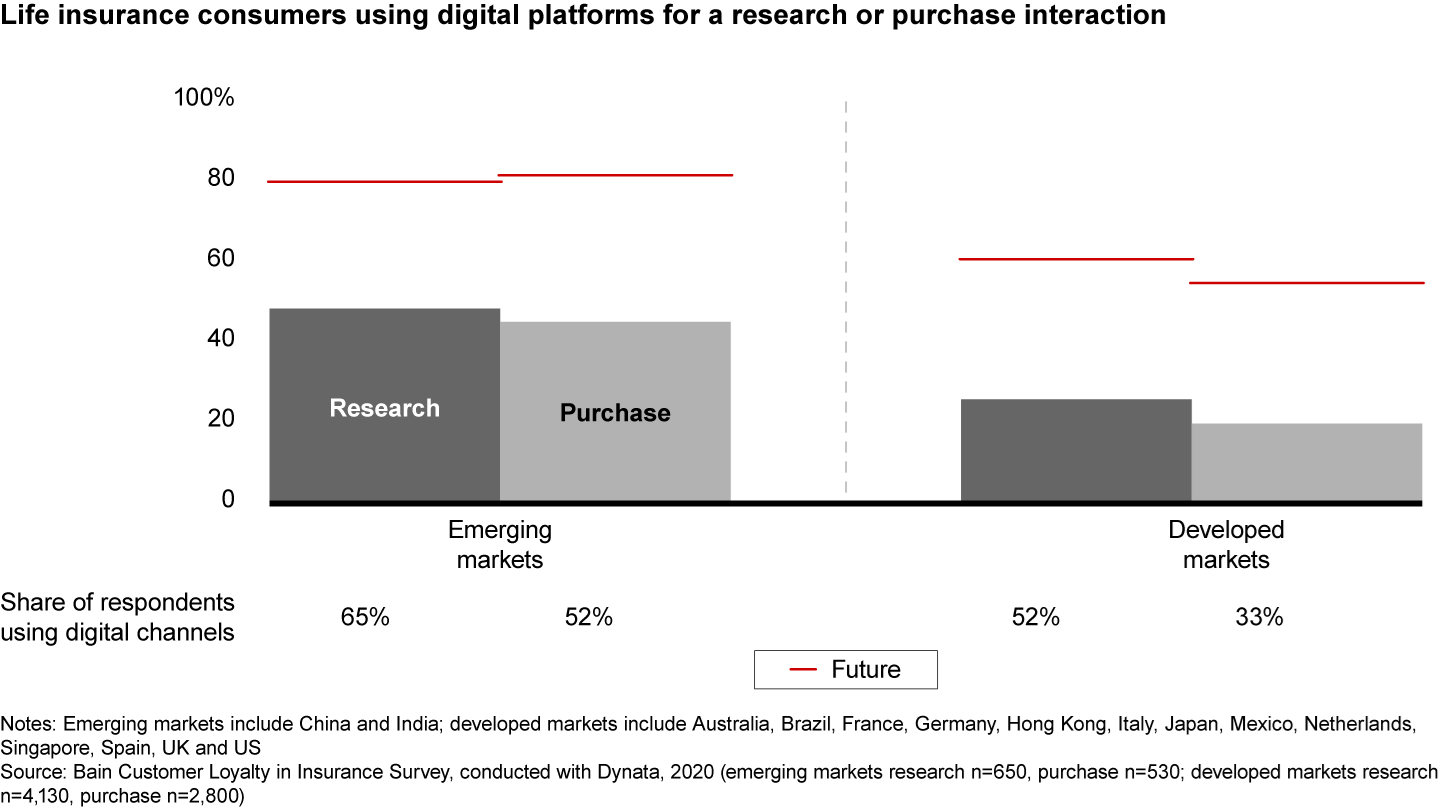
Respondents are generally open to buying insurance products from new entrants such as technology firms (see Figure 2). Among those consumers who favor large tech firms over traditional insurers, reliability and price were the key reasons cited. And respondents who have had a poor digital experience with their current insurer also are more likely to choose a tech giant for the next purchase.
Many consumers are open to buying insurance products from new entrants, mainly due to price and reliability

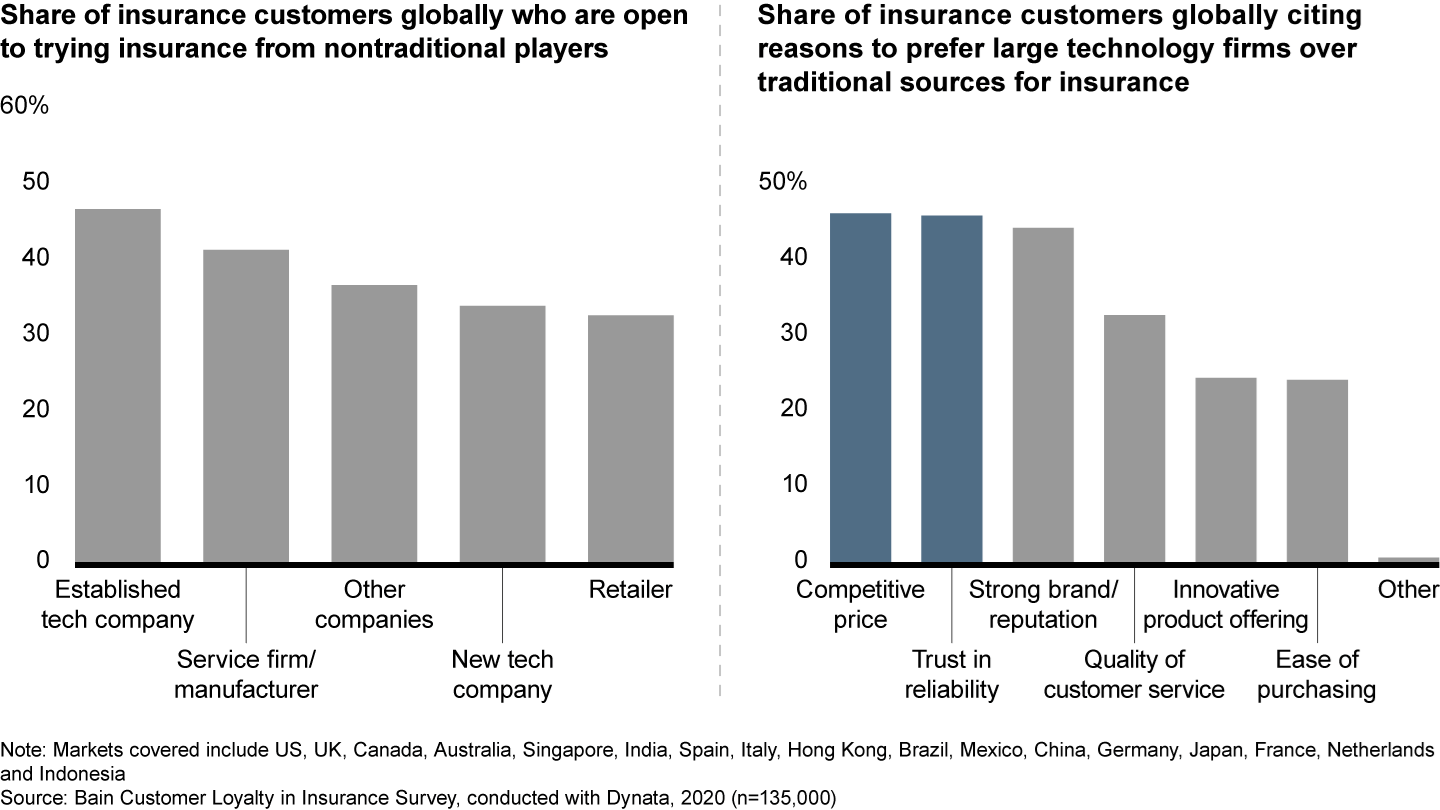
Some platforms now feature an ecosystem of related services, a trend accelerated by the Covid-19 pandemic. In health insurance markets, platform services include diagnostics, treatment and healthy living advice and, during the Covid-19 pandemic, more telemedicine services. In auto insurance, platforms offer purchase and sale, safe-driving discounts and emergency support. In home insurance, common services are security, energy and purchase and sale. In these markets, the pandemic has made people more comfortable buying insurance products and related services online.
Health services have seen the highest uptake so far, particularly in Asian developing markets (see Figure 3). The Indonesia-based Halodoc platform, for instance, offers integrated services connecting patients to practitioners and pharmacies. It has signed partnerships with Allianz, Prudential, BPJS Kesehatan and Mega.
Health-related services through insurance platforms have a higher uptake than auto and home services

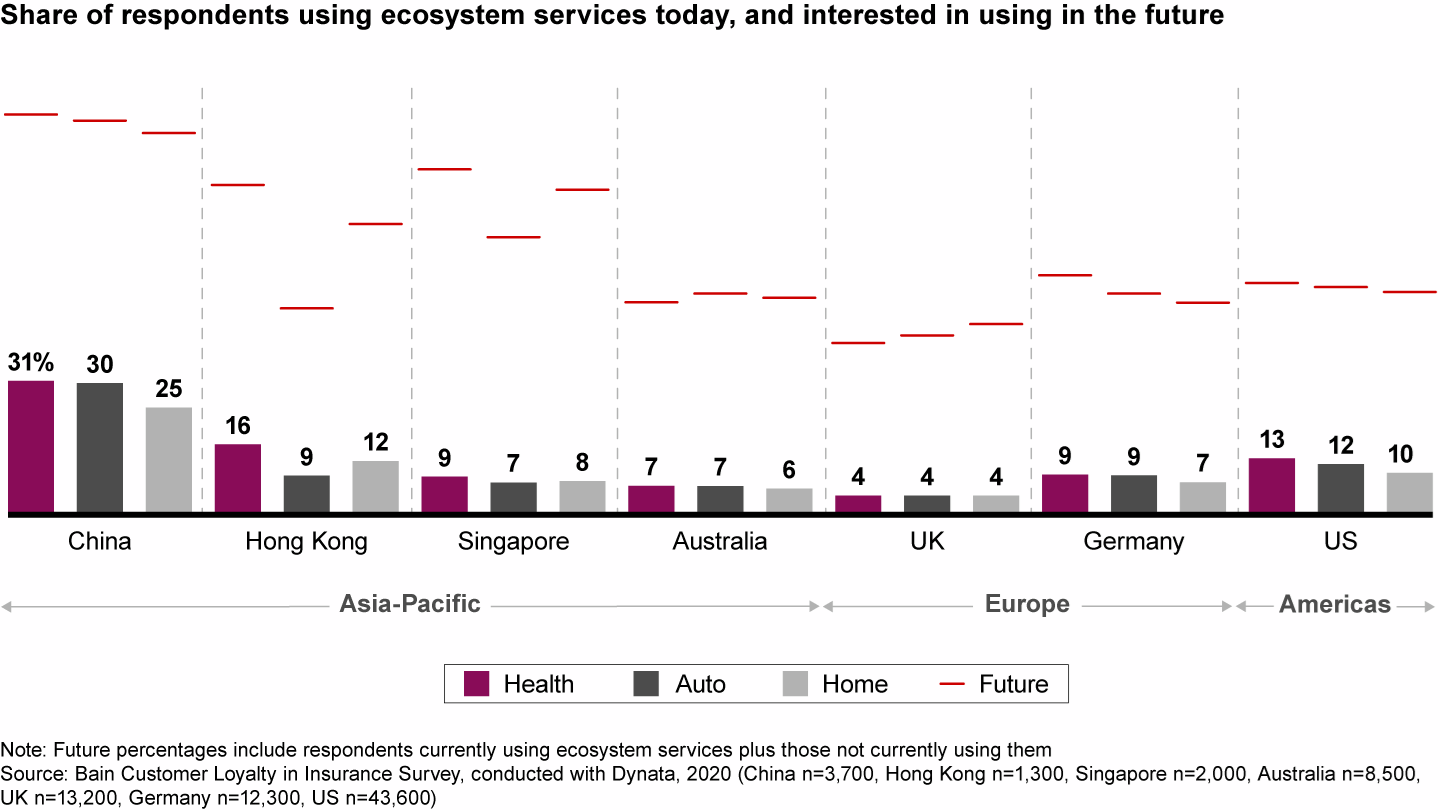
When respondents were asked about future interest in services, more chose healthcare companies than insurers as their preferred provider. In auto and home ecosystems, however, a majority of respondents said they were interested in insurers. The main reason: their past experience with insurers. Familiarity with the brand can be a huge asset. For example, existing customers of one health insurer in Asia are far more likely to want to try the insurer’s proposed new app with health-related services than noncustomers.
In search of better economics
Ecosystem services create an opportunity to influence purchase decisions or earn greater loyalty. A well-run platform orchestrated by an insurer helps the company to provide a distinctive, richer experience for customers, and to improve the economics in several ways: reduced risk and claims costs, improved underwriting, improved customer segmentation and tailored pricing, and potentially a price premium for certain services. As such, it can break even on a cash basis in three to five years.
Incumbent insurance companies do have an advantage currently: Customers who use ecosystem services from their insurer rate their experience higher than those who use services from noninsurance providers (see Figure 4). Such services have a strong influence on the insurance purchase decision. In Singapore, for instance, 84% of respondents said using health services from an insurer influenced their decision to purchase other insurance products. And many consumers would switch insurance providers to access the desired services. Some 44% of Singapore respondents who use ecosystem services are willing to switch providers, with 28% willing to pay a higher premium.
Customers who use ecosystem services through their insurer rate the experience higher than those using them through noninsurance providers

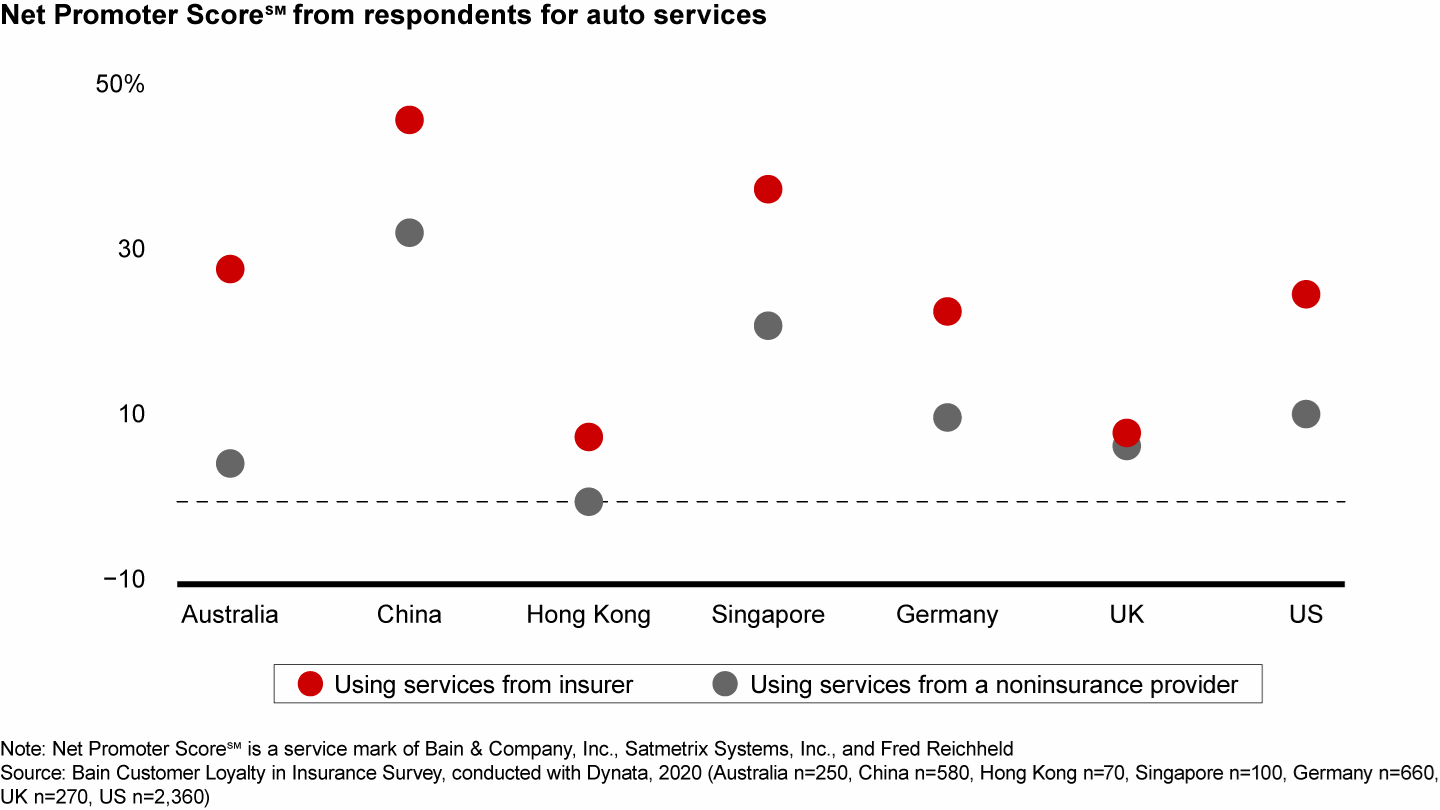
Platforms produce another benefit for companies: individual customer data, which can help insurers understand their customers better and serve them more effectively. That allows more personalization for customers acquired via a digital platform, leading to higher odds of conversion. In the UK, 64% of respondents who use or are interested in using ecosystem services said they would be willing to share data in return (see Figure 5). Insurers have an opening—perhaps even a responsibility—to provide better value to customers in exchange for this data.
Many consumers are willing to share their data with providers of insurance-related services

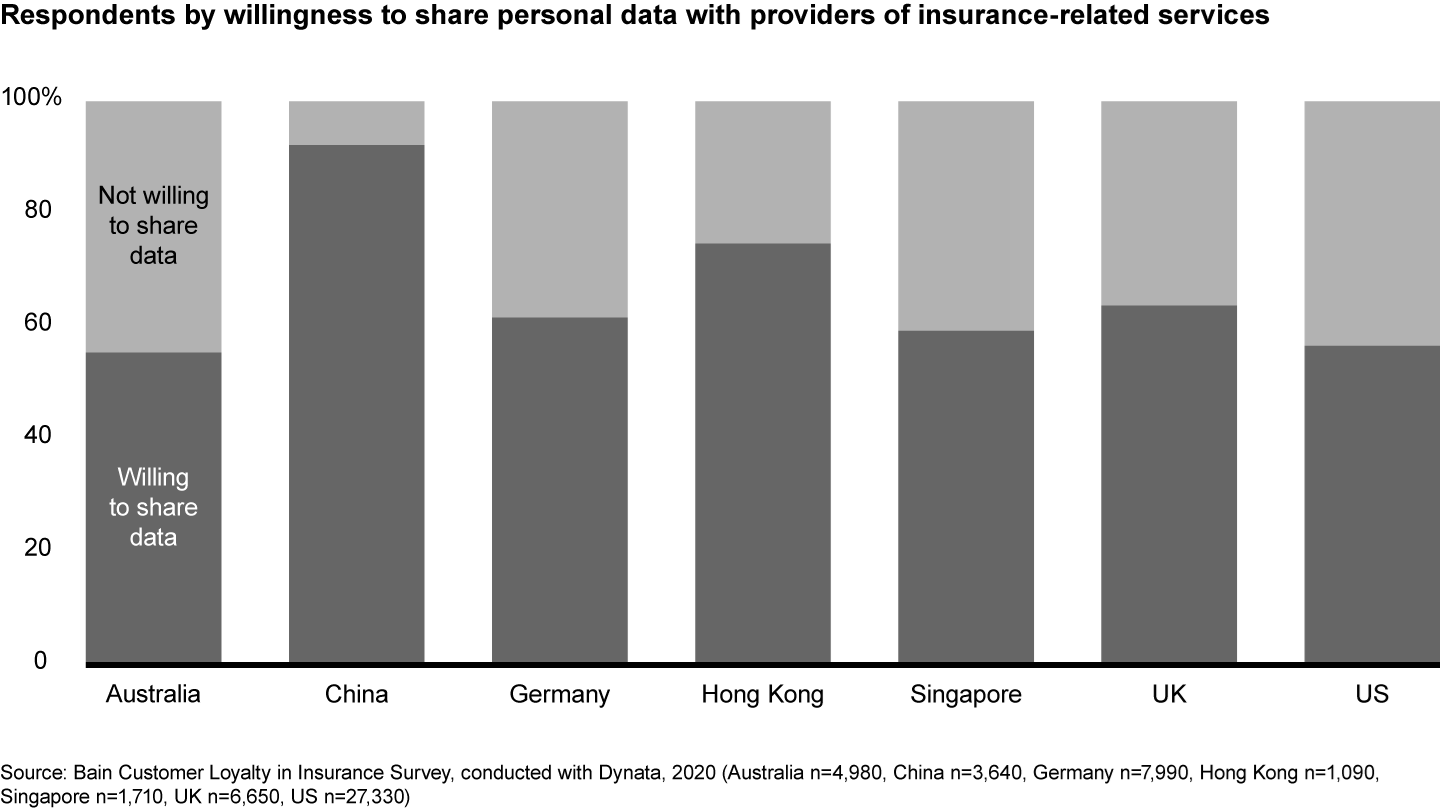
Platforms’ growing role and customers’ fluid attitudes raise key questions for insurers:
How can we differentiate ourselves? Services and products must be distinctive and compelling to attract new customers or improve engagement with existing ones. This involves tuning the value proposition for customers whose interactions are increasingly digital and have higher expectations of a simple, convenient, personalized experience. Expanding into additional value-added services can further that goal.
What is the right go-to-market approach? Insurers must decide whether to develop or orchestrate their own platform, or instead participate in another company’s platform. Orchestrating on one’s own requires scale and a major investment before payback. Big insurers will also have to reconcile the channel conflict that may arise with their current distribution partners.
Ping An in China has sufficient scale to run its own platforms. By contrast, in Europe, Allianz has partnered with Getaround to provide insurance for users of their car sharing platform, and has developed on-demand roadside assistance services directly on the Waze app.
Realistic alternatives for smaller firms could be to plug into another company’s platform, or perhaps become a preferred provider for a private label offering. For the latter, the economics will be tough but perhaps necessary to access this growing distribution channel.
What does success look like? Determining which metrics to use will help insurers steer the right level and type of resources and investment to their chosen platforms. Important metrics include the number of active users and partners, conversion rates, customer acquisition costs, revenue per customer, lifetime value and Net Promoter Score℠ (a key metric of loyalty).
Key steps to develop a platform
While there are many types of platform, successful ones result from carefully considered steps in several areas.
Clarify the company’s role. Will it be an orchestrator of complementary services, or a distributor? And what is the overall objective—attract new customers, improve engagement, gather useful data, or other?
Start with a compelling hook. The hook must have substantial value for customers when compared to the status quo.
Discovery, for example, pioneered a program to reward customers for healthy behavior through a wellness platform, Vitality. The related app tracks a member’s progress through data feeds in gyms, grocery stores and wearable technologies. Members redeem Vitality points for gift cards and coupons.
In India, Jio’s MyJio app offers customers a one-stop destination for broad set of offerings including movies, music and games. Users can access apps that also feature digital currency, payments services and an insurance premium payment service through JioMoney. Customers stay engaged through Jio’s loyalty program, reducing churn and opening up new avenues of monetization.
Use partners to expand offerings. In their bid to engage with a larger base of customers, tapping partners can allow insurers to minimize complexity. Paytm, with 39 million daily active users of its platform in India, collaborates with 20 leading insurance firms and is working to integrate with 30 more companies.
Construct a relevant and distinctive value proposition. Designing the core product and expanded offerings is just the first step; the platform also has to deliver services well. That typically comes from using an agile, test-and-learn approach.
Singapore-based Grab started with a strong value proposition for drivers, with more precise matching than competitors, shorter wait times and higher income. Increased availability, plus a lower cost to serve and improved map accuracy, improved the offering and earned greater loyalty. The company added personalized rewards and subscription plans for customers. And for drivers, it added working capital loans at more competitive interest rates, plus personalized car insurance based on driving patterns.
Ensure sound economics. Aside from the global tech giants, most platform providers struggle to achieve scale and profitability. Insurers thus need to carefully consider how they might monetize their participation in a platform. They need to generate leads, drive traffic and convert prospects—all a reasonable cost. While they will probably need to subsidize the platform initially, their focus should be on how to break even.
Among the ways to monetize are commissions, new customer acquisition, product upselling and cross-selling, loss reduction (through healthy behavior or warning of risks), revenue sharing, transaction fees and licensing fees.
In another area of financial services, Ping An has built a comprehensive auto services ecosystem that benefits automakers, dealers and repair shops through its subsidiaries. These partners buy Ping An’s data products and pay fees to participate on the platform and access the customer data. Customers get high-quality, one-stop service.
Platforms are no longer an inexpensive experiment, as the ticket to entry could reach $20 million to $50 million. Yet as platforms spread both geographically and throughout new corners of insurance markets, insurers must plant their flag soon, so as not to be left with inferior partners or limited choices.
The authors would like to thank the following colleagues for their contributions to the analysis related to this brief: Pency Tam, Sonal Chawla, Hridesh Sagar, Praneeth Iragavarapu, Rishabh Vasu, Eshita Gupta, Tarush Gupta, Vasu Agarwal and Chinoy Jain.
Net Promoter®, NPS®, and the NPS-related emoticons are registered trademarks of Bain & Company, Inc., Satmetrix Systems, Inc., and Fred Reichheld. Net Promoter Score℠ and Net Promoter System℠ are service marks of Bain & Company, Inc., Satmetrix Systems, Inc., and Fred Reichheld.

About the Research
Data powered by Dynata, a leading global first-party data and insights platform.